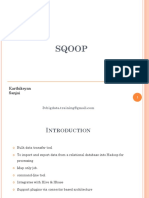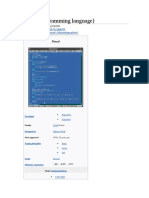SQL Python Connect
Uploaded by
HariOm DwivediSQL Python Connect
Uploaded by
HariOm DwivediIntroduction to Database Programming in Python
Interacting with a database is an important feature in many programming languages including python. In comparision to storing data in flat files, its much
easier to store, retrive and modify data in a database. We are going to learn the following concepts and programming skills.
Creating a Database connection
Creating a Database
Create a Table
Inserting into the table
Retrieving data from Table
Updating Records in a table
Deleting Data in a table
Before you can start working with MySQL database, you need to start the database server. I am using WAMP server for this tutorial. You also need to
install the latest mysql-connetor for this purpose. use pip install mysql-connector in the command window to download and install it.
Connecting to the database server
In [23]: import mysql.connector
con = mysql.connector.connect(host="localhost", user="root", passwd="")
mycursor = con.cursor()
con.close()
Creating a Database
In [3]: import mysql.connector
con = mysql.connector.connect(host="localhost", user="root", passwd="")
mycursor = con.cursor()
mycursor.execute("DROP DATABASE IF EXISTS student")
mycursor.execute("CREATE DATABASE student")
mycursor.execute("USE student")
Creating the Table
In [11]: mycursor.execute("DROP TABLE IF EXISTS studentinfo")
mycursor.execute("CREATE TABLE studentinfo (name VARCHAR(30), age INT(3), gender CHAR(1))")
Inserting data into the table
In [12]: sql = """INSERT INTO studentinfo(name, age, gender)
VALUES('Ashok',17,'M')"""
mycursor.execute(sql)
con.commit()
Inserting multiple rows simultaniously
Here we are going to use the executemany() function that accept two parameters as shpown below.
In [15]: sql = """INSERT INTO studentinfo(name, age, gender)
VALUES(%s, %s, %s)"""
rows = [('Amit', 18,'M'),('Sudha', 17, 'F')]
mycursor.executemany(sql, rows)
con.commit()
con.close()
Reading from Database Table
fetchone() − It fetches the next row of a query result set. A result set is an object that is returned when a cursor object is used to query a table.
fetchall() − It fetches all the rows in a result set. If some rows have already been extracted from the result set, then it retrieves the remaining rows
from the result set.
In [17]: import mysql.connector
con = mysql.connector.connect(host="localhost", user="root", passwd="", database="student")
mycursor = con.cursor()
sql = "SELECT * FROM studentinfo"
mycursor.execute(sql)
result = mycursor.fetchall()
for row in result:
name = row[0]
age = row[1]
gender = row[2]
print("Name=%s, Age=%d, Gender=%c" % (name,age,gender))
con.close()
Name=Ashok, Age=17, Gender=M
Name=Amit, Age=18, Gender=M
Name=Sudha, Age=17, Gender=F
Name=Amit, Age=18, Gender=M
Name=Sudha, Age=17, Gender=F
Updating records in a Table
In [1]: import mysql.connector
con = mysql.connector.connect(host="localhost", user="root", passwd="", database="student")
mycursor = con.cursor()
sql = "UPDATE studentinfo SET age=age-3 WHERE age='%d'" % (21)
mycursor.execute(sql)
sql = "SELECT * FROM studentinfo"
mycursor.execute(sql)
result = mycursor.fetchall()
for row in result:
name = row[0]
age = row[1]
gender = row[2]
print("Name=%s, Age=%d, Gender=%c" % (name,age,gender))
con.close()
Name=Ashok, Age=17, Gender=M
Name=Amit, Age=18, Gender=M
Name=Sudha, Age=17, Gender=F
Name=Amit, Age=18, Gender=M
Name=Sudha, Age=17, Gender=F
Deleting Records from a Table
In [ ]: import mysql.connector
con = mysql.connector.connect(host="localhost", user="root", passwd="", database="student")
mycursor = con.cursor()
sql = "DELETE FROM studentinfo WHERE name='%s'" % ('Ashok')
mycursor.execute(sql)
sql = "SELECT * FROM studentinfo"
mycursor.execute(sql)
result = mycursor.fetchall()
for row in result:
name = row[0]
age = row[1]
gender = row[2]
print("Name=%s, Age=%d, Gender=%c" % (name,age,gender))
con.close()
You might also like
- Apache Cassandra Administrator Associate - Exam Practice TestsFrom EverandApache Cassandra Administrator Associate - Exam Practice TestsNo ratings yet
- TALEND ESB 6.0 Cours 1444874212 - 00 - Course - LessonTOC - 13 Files MergedNo ratings yetTALEND ESB 6.0 Cours 1444874212 - 00 - Course - LessonTOC - 13 Files Merged203 pages
- A.2.2 Outline The Functions and Tools of A DBMS.: 1. Data Dictionary ManagementNo ratings yetA.2.2 Outline The Functions and Tools of A DBMS.: 1. Data Dictionary Management3 pages
- Spark DataFrames Project Exercise - Jupyter NotebookNo ratings yetSpark DataFrames Project Exercise - Jupyter Notebook7 pages
- How Sqoop Works?: Sqoop "SQL To Hadoop and Hadoop To SQL"No ratings yetHow Sqoop Works?: Sqoop "SQL To Hadoop and Hadoop To SQL"27 pages
- Geospatial Data Abstraction Library (GDAL) - UtilitiesNo ratings yetGeospatial Data Abstraction Library (GDAL) - Utilities31 pages
- Nosql Database Systems: M.Tech. (Iind, Sem Ce/Cn)100% (1)Nosql Database Systems: M.Tech. (Iind, Sem Ce/Cn)135 pages
- My) SQL Cheat Sheet: Mysql Command-Line What How Example (S)No ratings yetMy) SQL Cheat Sheet: Mysql Command-Line What How Example (S)3 pages
- Mongodb Vs Couchbase Architecture WP PDFNo ratings yetMongodb Vs Couchbase Architecture WP PDF45 pages
- Crunchy Postgresql High-Availability Suite Keeps Critical Applications RunningNo ratings yetCrunchy Postgresql High-Availability Suite Keeps Critical Applications Running2 pages
- AI in Education-V.4 23-08-17 (Final) - 0No ratings yetAI in Education-V.4 23-08-17 (Final) - 025 pages
- Parallel Distributed Architecture For Storage and Sharing (PDash)No ratings yetParallel Distributed Architecture For Storage and Sharing (PDash)6 pages
- SQL-Transactions Theory and Hands-On ExercisesNo ratings yetSQL-Transactions Theory and Hands-On Exercises85 pages
- The Best of Bruce's Postgres Slides: Ruce OmjianNo ratings yetThe Best of Bruce's Postgres Slides: Ruce Omjian26 pages
- The Definitive Guide to Data Integration: Unlock the power of data integration to efficiently manage, transform, and analyze dataFrom EverandThe Definitive Guide to Data Integration: Unlock the power of data integration to efficiently manage, transform, and analyze dataNo ratings yet
- Connect To Your Linux Instance From Windows Using PuTTYNo ratings yetConnect To Your Linux Instance From Windows Using PuTTY4 pages
- Update Arcgis Enterprise 10 9 Functionality MatrixNo ratings yetUpdate Arcgis Enterprise 10 9 Functionality Matrix13 pages
- (NGPP Modernization - Event Documents) NGPP Modernization RFQNo ratings yet(NGPP Modernization - Event Documents) NGPP Modernization RFQ5 pages
- ANP - 11. Basic TCP Client-Server Programming On UNIXNo ratings yetANP - 11. Basic TCP Client-Server Programming On UNIX3 pages
- Assignment No - 01 Title: Shell Programming: Software Laboratory - IiNo ratings yetAssignment No - 01 Title: Shell Programming: Software Laboratory - Ii5 pages
- Siwes Technical Presentation: Adelaja, Mary Adebimpe 08CG07728No ratings yetSiwes Technical Presentation: Adelaja, Mary Adebimpe 08CG0772816 pages
- Original Slides by Daniel Liang Modified Slides by Salam AbdullaNo ratings yetOriginal Slides by Daniel Liang Modified Slides by Salam Abdulla112 pages
- Department of Computer Science and EngineeringNo ratings yetDepartment of Computer Science and Engineering25 pages
- Pascal (Programming Language) : Jump To Navigationjump To SearchNo ratings yetPascal (Programming Language) : Jump To Navigationjump To Search16 pages
- Microsoft - Excel - VBA - and - Macros - Office - 2021 - and - Microsoft - 365-156-186 Chapter 4 VbaNo ratings yetMicrosoft - Excel - VBA - and - Macros - Office - 2021 - and - Microsoft - 365-156-186 Chapter 4 Vba31 pages
- Chapter 7 - Transportation Model (Part 1)No ratings yetChapter 7 - Transportation Model (Part 1)27 pages
- PYTHON Learn Python Programming in 90 Minutes or Less Python Learning Python Python Programming Python Tutorial Python Programming For Beginners Python For Dummies Book 1 PDF90% (10)PYTHON Learn Python Programming in 90 Minutes or Less Python Learning Python Python Programming Python Tutorial Python Programming For Beginners Python For Dummies Book 1 PDF161 pages
- Requirements Analysis: A Review: Joseph T. CatanioNo ratings yetRequirements Analysis: A Review: Joseph T. Catanio2 pages

























































































